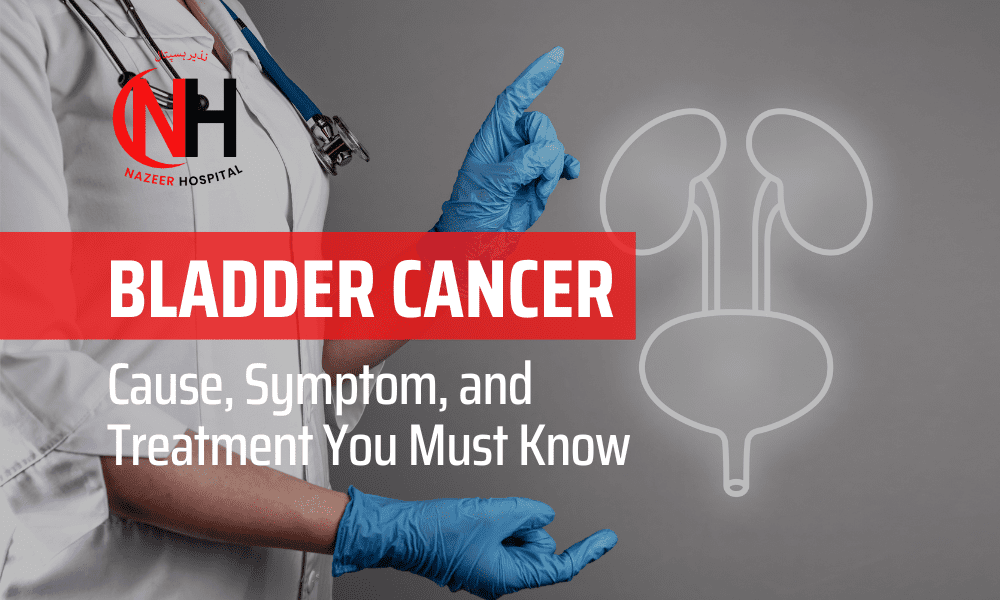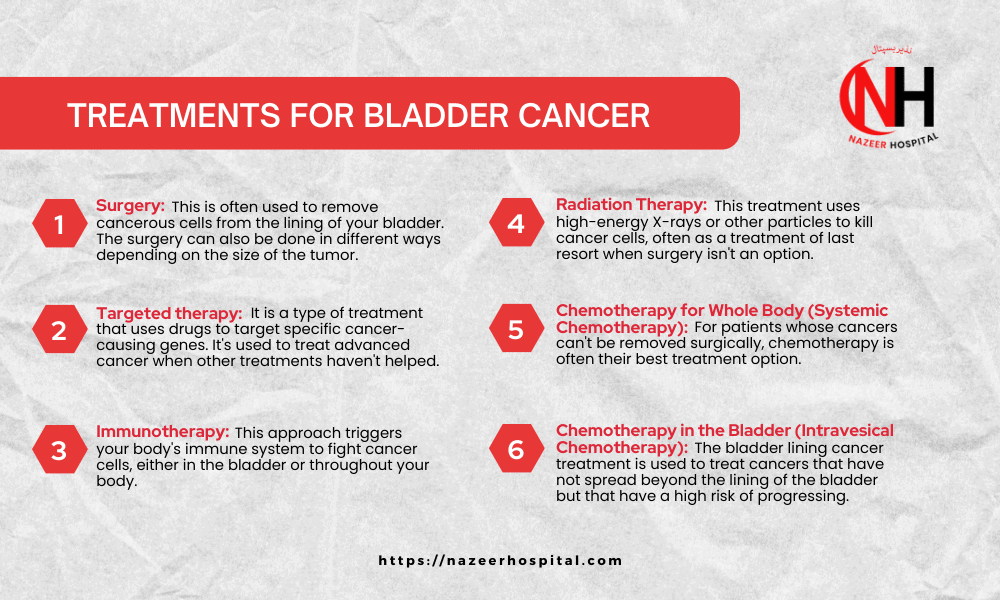Bladder Cancer – Cause, Symptom, and Treatment You Must Know
Updated on Feb 7, 2023

Bladder cancer is a disease caused by cells in the lining of the bladder turning into unhealthy and out-of-control cells that form tumors. The bladder is a hollow organ in the pelvis. It stores urine (liquid waste) before releasing it out of your body during urination. The bladder wall is covered with a layer of cells called the Urothelium. This layer of cells is separated from bladder wall muscles by a thin fibrous band called Lamina Propria.Bladder wall muscles control the bladder’s ability to expand and contract, which allows it to expand to accommodate more urine as needed. The muscle contraction also helps empty urine out of the bladder when you urinate. The urothelium layer protects your bladder from germs and other harmful substances that could cause an infection if they get inside your body through your urethra.
An Introduction
Itis caused by cells in the lining of the bladder that form tumors. A tumor can be cancerous or benign. A cancerous tumor is also known as a malignant tumor and can grow and spread to other body parts, while a benign tumor can grow but will not spread. Benign bladder tumors are sporadic.

Cancers that start in the cells that line your bladder are called transitional cell carcinomas. These cancers may also be called TCCs or urothelial carcinomas. Transitional cell carcinoma is the most common type of this cancer, making up about 90% of the cases.Most transitional cell carcinomas are small and stay in your bladder, where they can be removed with surgery. However, some TCCs spread outside your bladder into nearby lymph nodes or other organs like your kidneys or lungs. If this happens, it’s called metastasis (M). When this happens, it’s known as an advanced disease (AD).
Risk Factors
Before moving to risk factors of this cancer, let us also consider the etiology and epidemiology. They are both important to public health. The study of the causes of a disease is called etiology, and how diseases spread and affect populations, is known as epidemiology.Etiology seeks to explain why people contract a disease in the first place. Epidemiology aims to identify a particular disease’s prevalence and where it occurs. If you’re at risk of bladder cancer, know what are the contributing factors and in which people/parts of the world it is most common.This cancer is the seventh most common cancer worldwide and twice as common in Caucasians compared to African Americans. It affects about 600,000 people each year and is the second leading cause of cancer death in men.
Tobacco Usage or Smoking
Smoking is one of the most critical risk factors for bladder cancer as it increases your chances of getting it by 2 to 6 times that of non-smokers.
Age
Age raises the likelihood of developing this cancer. More than 70% of patients are over 65.
Gender
Although women are more likely than males to die from this cancer, men are four times more likely to develop the disease. Women may also encounter a bladder cancer diagnosis that is delayed.
Race
While african/african-american individuals are twice as likely as Caucasians people to be diagnosed with this cancer, african/african-america are also twice as likely to die from the condition.
Chemicals
Risk can also be increased by naturally occurring chemicals, compounds termed aromatic amines, and chemicals used in the textile, rubber, leather, dye, paint, and print industries.
Previous radiation therapy to the pelvis
Radiation therapy to the pelvis during cancer treatment may raise the risk of developing the cancer later on.
Chronic bladder problems
The risk may be increased by bladder stones and infections. People who are paralyzed from the waist down, need to use urine catheters, have frequent urinary infections, and are paralyzed from the hips down may be more likely to develop this cancer.
Cyclophosphamide use
Cyclophosphamide chemotherapy patients are more likely to develop bladder cancer than the general population.
Pioglitazone (Actos) use
The U.S. Food and Drug Administration (FDA) issued a warning in 2011 stating that risk of this cancer may be increased in those taking the diabetic medication pioglitazone for longer than a year. Published research, however, has shown conflicting findings.
Personal history
Recurrent bladder cancer is more likely to occur in people who have already experienced it.
Schistosomiasis
Some kinds of this parasite illness increase a person’s risk of developing squamous cell cancer. In several regions of Africa, South America, Southeast Asia, and the Middle East, schistosomiasis is a problem.
Lynch syndrome and other genetic syndromes
The chance of developing the cancer may be higher in people who have Lynch syndrome, formerly known as hereditary nonpolyposis colorectal cancer (HNPCC), or other genetic predispositions (upper and lower tract). It is crucial to discuss your family’s cancer history with your doctor.
Arsenic exposure
Arsenic is a naturally occurring substance that, if consumed in excessive quantities, can have negative effects on one’s health. It has been linked to a higher risk of bladder cancer when it is present in drinking water. Where you reside and whether you get your water from a well or from a system that complies with permitted arsenic levels determine your risk of exposure to arsenic.
Types Of Bladder Cancer
- Urothelial Carcinoma – also called transitional cell carcinoma, accounts for about 90% of all cancers. It is the most common type of cancer, and it occurs in the cells that line the inside of the urinary bladder.
- Squamous Cell Carcinoma – accounts for about 4% of all cancers. It occurs in the cells that line the inside of the urinary bladder.
- Adenocarcinomas – account for about 2% of all cancers. It occurs in glandular cells that make up part of your ureters, tubes that carry urine from your kidneys to your urinary bladder. These tumors are typically found in people with a smoking history or who have been exposed to certain chemicals (such as asbestos).
Stages of Bladder Cancer and What to Expect
Stage 1
Stage 1 bladder cancer is a very early stage of the disease and is the most common type. It is not life-threatening and can be cured with treatment. Early cancer solely affects the bladder’s inner lining’s surface. Cancer cells tend to cluster together and are frequently simple to eliminate. Muscle or connective tissue in the bladder wall has not been affected by cancer. Noninvasive papillary urothelial carcinoma is another name for this particular form of cancer.Most people with stage 1 bladder cancer can complete treatment. Cancer may grow smaller or may disappear altogether. People with stage 1 cancer may experience some temporary side effects from treatment, but these usually go away after complete treatment.`
Stage 2
Stage 2 bladder cancer is a more advanced form of the disease. It is more likely to spread to other parts of the body and is more challenging to treat. This cancer stage, also known as a flat tumor or carcinoma in situ (CIS), only affects the bladder’s inner lining. The bladder’s thick layer of muscle or connective tissue has not been invaded nor spread to the hollow portion of the bladder. Because it might develop into a sickness that invades the muscles, this malignancy is always of a high grade and is regarded as an aggressive condition.Stage 2 cancer often progresses slowly and may not require any treatment. However, it can occasionally become aggressive and require Treatment. Treatment Options May Include Surgery, Radiation Therapy, And/Or Chemotherapy.
Stage 3
Stage 3 bladder cancer is a more advanced form of the disease. It is more challenging to treat and has a higher risk of recurrence. The fatty layer of tissue around the bladder (peri vesical tissue), the prostate, the uterus, and the vagina have all been affected by cancer that has progressed across the muscular wall. Or the lymph nodes in the area have been affected by cancer.Stage 3 cancer is a severe condition that requires treatment. Treatment may include surgery, chemotherapy, and radiation. The prognosis for stage 3 cancer is generally good, but cancer may return, and there is a chance of death.
Stage 4
Cancer has spread to other body parts, and it is often deadly and may no longer be cured. However, advanced treatment options are limited. Stage 4 bladder cancer is very advanced and has an abysmal prognosis. Treatment typically includes surgery to remove the cancerous tissue and chemotherapy or radiation therapy to prevent cancer from returning. Patients may also require lifelong treatment to maintain their quality of life.
Stage 5
Stage 5 bladder cancer is severe cancer that has spread to other body parts. It is the most advanced form and is very difficult to treat. The tumor has not spread to other body parts except to the abdominal or pelvic walls. Or the lymph nodes outside the pelvis have been affected by the malignancy. It is a very serious condition and can lead to death if not treated. Treatment typically includes surgery, radiation therapy, and chemotherapy.
Symptoms and History of Bladder Cancer
It is a tumor occurring in individuals (>60 years). It is the most common urologic malignancy, with an annual incidence of 10-12 per 100,000. Most symptoms include:

Other less common symptoms include frequency and constitutional symptoms such as fatigue, weight loss & pelvic mass.
Symptoms – Female and Male
- Frequent urge to urinate
- Blood in the urine
- Foul Smell in Urine
- Pain while urinating
- Trouble urinating
- A lump or mass on the side of your bladder
- Burning while urinating
- And more
This health condition develops after the 20th week of pregnancy and lasts until delivery. There are two types of preeclampsia: mild and severe.
Early Symptoms in Females
The most common symptoms of this cancer in females are urinary frequency, urinary urgency, and burning during urination. Other symptoms may include blood in the urine, pain when passing urine, and a change in the amount of urine produced.
Early Symptoms in Males
The earliest symptoms of this cancer in males may include the following:
- A change in the amount or consistency of urine.
- Sudden, severe pain in the side of the bladder.
- A feeling of unusual weight inside the bladder.
- A frequent need to urinate.
- An unusual smell of urine.
Treatment and Diagnostics
The diagnosis of bladder cancer is made through a combination of medical history and several diagnostic tests. The diagnostic tests include:
- Ultrasound – uses sound waves to produce images of the inside of the body.
- Intravenous Urography (Ivu) – injects dye into a vein in the arm and takes X-ray pictures.
- Computed Tomography (Ct Scan) – takes multiple X-rays from different angles to create cross-sectional images of internal organs or tissues.
- Magnetic Resonance Imaging (Mri) – uses radio waves and strong magnetic fields to produce detailed images of internal organs or tissues without harmful radiation.
- Cystoscopy – is considered the standard for the initial management of bladder cancer.
Your doctor considers all these factors, along with your overall health and treatment preferences, to determine which treatment option is best for you.
Treatments of Bladder Cancer
When diagnosed with bladder cancer, you may be overwhelmed by the number of treatment options available.Your treatment options for bladder cancer depend on several factors, including:
- The type of cancer
- Grade of cancer
- Stage of cancer
Here’s a breakdown of the most common treatments for bladder cancer:

Bladder Cancer Age Group
The risk of developing bladder cancer increases with age, and people over 55 are more likely to develop the disease. However, this cancer can occur at any age. If you have a family history of bladder cancer, you are at a higher risk of developing it.
Noninvasive Bladder Cancer Recurrence
Noninvasive bladder cancer is cancer that does not invade the bladder through the urethra but originates in the bladder lining. This type of cancer is more common in older adults and is more likely to be diagnosed in men than in women.Noninvasive bladder cancer (NIC) recurrence rates vary depending on the type of cancer and its stage at the recurrence time. The most common type of NIC recurrence is a local recurrence, which occurs when the cancer cells return to the same part of the bladder where they originated.Recurrence rates for bladder cancer vary depending on the stage of the first tumor, with 5-year recurrence rates of roughly 65% in patients with noninvasive or aggressive bladder cancer and 73% in patients with slightly more advanced disease at first diagnosis.
BCG Treatment for Success Rate
Treatment typically depends on the stage of cancer, the extent/duration of the cancer, and the patient’s health and preferences. Standard treatment may include surgery, chemotherapy, radiation therapy, and/or hormonal therapy but BCG treatment for bladder cancer is a vaccine that helps the body fight cancer. BCG therapy is also called BCG vaccine therapy.Bacillus Calmette-Guerin, or BCG, is the most popular intravesical immunotherapy for treating bladder cancer in its early stages. It is used to help prevent cancer from spreading and returning. Although the BCG bacterium is linked to the one that causes tuberculosis (TB), it typically doesn’t result in significant illness.This course of therapy is regarded as an instance of immunotherapy, a newly developed cancer therapy. The BCG (Bacillus Calmette-Guerin) treatment is effective, and the success rate for BCG Urinary Bladder Cancer treatment is approximately 90%.
Precautions to Avoid
You can do several things to reduce your risk of developing bladder cancer. One of the best ways to prevent bladder cancer is by quitting smoking as it causes oxidative damage to your cells, increasing your chances of developing bladder cancer. If you do smoke, try quitting as soon as possible.
Taking precautions around chemicals is another way to reduce your risk of bladder cancer. Chemicals such as benzene, vinyl chloride, and arsenic have increased the risk of developing this disease. You can avoid exposure by using gloves when working with these chemicals or choosing safer alternatives if possible. Finally, dietary modifications may help decrease your risk as well. A diet high in fruits and vegetables has been shown to reduce the chances of developing bladder cancer, while a diet high in red sintomasdelsida.org meat may increase it.
Kidney and Bladder Cancer Prognosis and Complications
The prognosis for patients with bladder cancer depends on the stage of their cancer and whether or not it has spread to other parts of their body. If it has not spread, then the patient has an 80% chance of being cured after treatment. But the best thing is to record your health through proper checkups after every few months. So that you know what changes are happening inside your body, and if you are diagnosed with any disease, it can be diagnosed and treated at the initial stages.

Frequently Asked Questions
What are the warning signs of bladder cancer?
- Urinary blood or blood clots
- Urination that causes pain or burning
- Urinating frequently
- Having frequent urges to urinate all through the day
- Being in need of urination yet unable to urinate
- Experiencing lower back pain on one side
What is the life expectancy of Bladder Cancer?
You can get an idea of the percentage of persons with the same type and stage of cancer who are still alive after a particular period (often five years) from the time of their diagnosis by looking at survival rates.
What is usually the first symptom of bladder cancer?
Blood in the urine, commonly known as hematuria, is the majority of people’s first indication that they have bladder cancer. The patient is sometimes prompted to see a doctor when the blood is visible.
Is Bladder Cancer usually fatal?
Urinary bladder cancer patients have a 77% 5-year survival rate overall. The kind and stage of bladder cancer at the time of diagnosis are just two variables affecting survival rates. People with bladder cancer who have not progressed past the inner layer of the bladder wall have a 96% 5-year survival rate.
Is bladder cancer curable?
Most bladder cancer cases are discovered in their early stages when they are pretty curable. However, even early-stage bladder tumors might recur following a curative regimen. Because of this, bladder cancer patients frequently require follow-up checkups for years following treatment to look for bladder cancer that returns.
What is the leading cause of Bladder Cancer?
The highest risk factor for bladder cancer is smoking. This is due to the compounds in tobacco, which are known as carcinogens. If you smoke for a long time, your kidneys filter these toxins into urine before they enter your bloodstream.
Doctor Saad Aziz

MBBS, RMP051-8742883contact@nazeerhospital.com
As a graduate of University of Health Sciences Lahore, I have acquired extensive expertise in medicine and hospital settings. I excel in accurate diagnosis and creating effective patient treatment plans.
I am known for my empathetic and professional attitude, with a commitment to providing my patients with the highest standard of care. I have served at several prominent hospitals, including:
- Divisional Headquarter Hospital Mirpur
- Combined Military Hospital Rawalpindi
- Pak Emirates Military Hospital Rawalpindi
- Fauji Foundation Hospital Rawalpindi
My wealth of medical knowledge is complemented by my focus on patient counseling and promoting positive lifestyle changes. I am also proud of my contributions to medical research and the several articles I have published.
